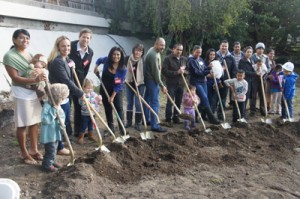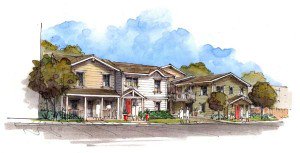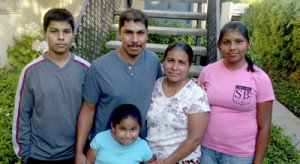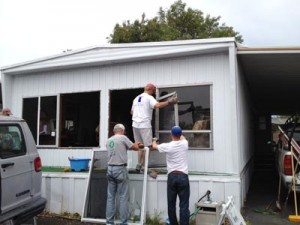By Leah Etling on January 24, 2013 in Giving People
 Sometime in 2014, 12 low-income Santa Barbara families will be able to move into newly constructed homes at Canon Perdido and Milpas streets, structures that they own and built in part with their own sweat equity.
Sometime in 2014, 12 low-income Santa Barbara families will be able to move into newly constructed homes at Canon Perdido and Milpas streets, structures that they own and built in part with their own sweat equity.
The latest project from Habitat for Humanity of Southern Santa Barbara County, the Canon Perdido Homes are the non-profit’s largest construction effort to date, and will allow its residents to leave behind the sub-standard conditions they are currently living in.
“This is our largest project to date. These homes will provide housing for 43 people, 20 of whom are children,” said Alex Ramstrum, Development Manager for Habitat for Humanity of Southern Santa Barbara County.
 The project broke ground in mid-December and completion is expected to take about 18 months. Most of the construction will be the work of volunteers and the future homeowners, who will work under the tutelage of a professional contractor foreman and expert craftsmen volunteers. Each adult must contribute 250 hours of labor time toward their future residence.
The project broke ground in mid-December and completion is expected to take about 18 months. Most of the construction will be the work of volunteers and the future homeowners, who will work under the tutelage of a professional contractor foreman and expert craftsmen volunteers. Each adult must contribute 250 hours of labor time toward their future residence.
A popular volunteer opportunity for hundreds of community members each year, Habitat needs people power not only to participate in construction projects, but to help staff its ReStore, a retail center for recycled building materials in Goleta, and to participate in “A Brush with Kindness”, which completes exterior maintenance projects for homeowners in need. Here are the income level maximums for Brush with Kindess recipients.
Yardi has had several employee “build” days with Habitat. The largest group was a team that worked for a day swinging hammers on the San Pasqual project in 2010. Other groups have worked at the ReStore.
Rob Teel , Yardi’s Senior Vice President of Global Solutions, serves on the organization’s Board of Directors.
 “For me, Habitat is the perfect charity to combine my work, local, and ethical interests. The idea of providing a home for a family not only builds hope for those individuals, but it has a major impact on the health and hope of the surrounding community,” Teel said.
“For me, Habitat is the perfect charity to combine my work, local, and ethical interests. The idea of providing a home for a family not only builds hope for those individuals, but it has a major impact on the health and hope of the surrounding community,” Teel said.
Opportunities to volunteer on the Canon Perdido construction project will commence in the spring after underground construction is complete and foundations are laid, Ramstrum said. Interested volunteers can register to donate their time at this link. Donations for the project are still being collected as part of the Building Homes, Building Hope campaign.
The development includes 2 three-bedroom units, 8 two-bedroom units, and 2 one-bedrooms, one of which will be accessible to disabled persons. The units will range between 750 and 1,200 square feet each.
To qualify for a home in the project, the selected families went through an intensive selection process that included interviews, visit to their current housing situation, and financial review to ensure they met the income criteria for Habitat homeowners. Selected families can make no more than 80 percent of the region’s median income, many make far less. Demonstrating the need for affordable housing in South Santa Barbara County, hundreds of people attended early meetings about the Canon Perdido project, and eventually the 12 families selected were chosen from 115 applications.
In addition to contributing 250 hours of labor per person toward their homes, the families will pay off interest-free mortgages carried by Habitat for Humanity. Mortgage costs never exceed 35 percent of residents’ incomes.
 Yardi Systems has been a corporate supporter of the South Coast’s Habitat chapter since 2007, donating funds toward all three of the non-profit’s local housing projects. Previous Habitat developments are located on the Westside of Santa Barbara on San Pasqual Street and off of Upper State Street on Via Lucero.
Yardi Systems has been a corporate supporter of the South Coast’s Habitat chapter since 2007, donating funds toward all three of the non-profit’s local housing projects. Previous Habitat developments are located on the Westside of Santa Barbara on San Pasqual Street and off of Upper State Street on Via Lucero.
For the Canon Perdido project, Yardi’s contributions will pay for the doors and windows of the homes, which are designed to meet the environmental standards of Built Green Santa Barbara. Building methods and construction materials will create well-insulated structures that lead to utility savings for the homeowners. The goals is to achieve “net zero” energy usage by combining passive components such as window placements, insulation, and building wrap with “active” components such as solar thermal and photovolatic systems.
Have you ever had the chance to volunteer on a Habitat for Humanity project anywhere in the USA? Tell us about your experience in the comments section. We know that dozens of Yardi employees have contributed to these community building projects nationwide.













